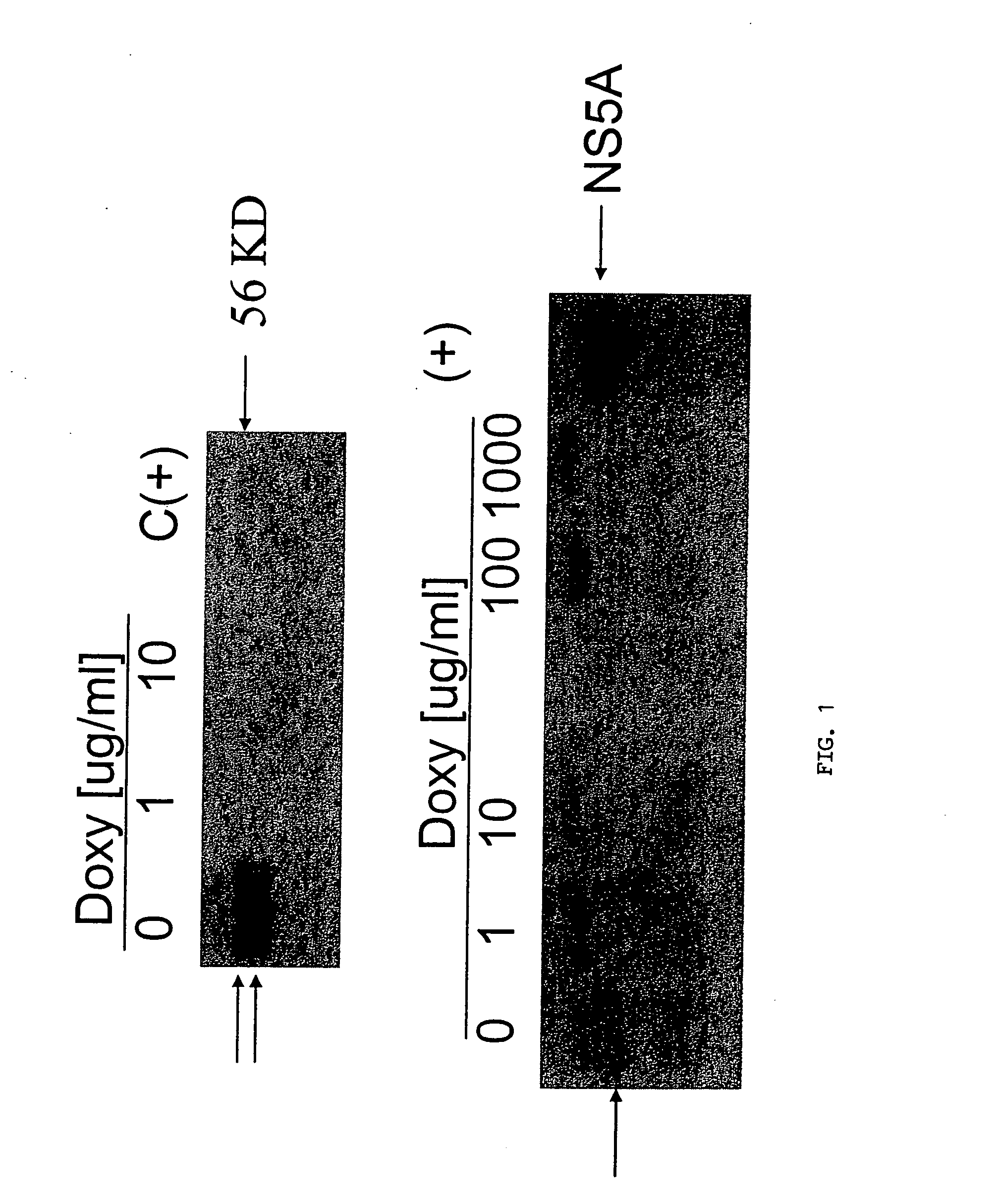Flavivirus NS5A proteins for the treatment of HIV
a technology of flavivirus and protein, applied in the field of molecular biology and virology, can solve the problems of no effective cure, no longer equipped individual immune system to fight, and uncommon findings, and achieve the effect of reducing hiv replication
- Summary
- Abstract
- Description
- Claims
- Application Information
AI Technical Summary
Benefits of technology
Problems solved by technology
Method used
Image
Examples
example 1
[0163] Cells: Tet-Off Jurkat cells (Clontech) were transfected with pTRE 2 Hyg plasmids containing full-length GBV-C NS5A (from the full-length GBV-C infectious clone AF121950) or with the vector only (control) by electroporation. Transfectants were selected using hygromycin, and cell lines cloned twice. Cells were grown in RPMI 1640 with or without doxycycline as recommended.
[0164] NS5A expression: Cells were lysed in RIPA buffer containing protease and phosphatase inhibitors and examined by immunoblot using rabbit anti-NS5A antisera.
[0165] HIV infections: Clinical and laboratory CXCR4 tropic strains of HIV-1 were used to infect Jurkat cell lines expressing NS5A or the vector control. Cells were maintained in doxycycline at various concentrations to inhibit NS5A expression. HIV replication was measured using culture supernatant p24 antigen ELISA.
[0166] Results: Jurkat cell lines stably expressing GBV-C NS5A protein were established, and expression of NS5A was regulated by doxycy...
example 2
NS5A Inhibition of HIV Replication is Dose Dependent, Independent of PKR and May Involve SDF-1
[0168] Using Jurkat cells that are infected with HIV, doxycycline-repessable expression constructs encoding GBV-C NS5A were used to inhibit HIV replication. As shown in FIG. 8, the use of 0, 0.01, 0.1 and 1 jig of doxycycline produced decreasing amounts of HIV inhibition as measured by p24 antigen levels. No such effect was seen in control Jurkat cells.
[0169] The inventors previously showed that NS5A's from interferon resistant (IFN-R) GBV-C inhibited PKR-mediated phosphorylation of eIF2α, which is part of the inteferon cascade, whereas interferon sensitive (IFN-S) did not. The NS5A's from IFN-R and IFN-S strains were compared for their respective abilities to inhibit HIV replication. As shown in FIG. 9, both strains were equally effective at inhibiting HIV replication as measured by p24 antigen concentration. Thus, the effect is apparently not related to PKR-function.
[0170] Following tr...
example 3
NS5A Inhibits Distinct Strains of HIV
[0171] Three different strains of HIV—ELI (X4) Clade D, JF (X4) Clade B and MN (X4) Clade B—were tested for replication in the presence of NS5A. As shown in FIGS. 11A-C, all were sensitive to NS5A-mediated inhibition.
PUM
| Property | Measurement | Unit |
|---|---|---|
| Volume | aaaaa | aaaaa |
| Volume | aaaaa | aaaaa |
| Volume | aaaaa | aaaaa |
Abstract
Description
Claims
Application Information
 Login to View More
Login to View More - Generate Ideas
- Intellectual Property
- Life Sciences
- Materials
- Tech Scout
- Unparalleled Data Quality
- Higher Quality Content
- 60% Fewer Hallucinations
Browse by: Latest US Patents, China's latest patents, Technical Efficacy Thesaurus, Application Domain, Technology Topic, Popular Technical Reports.
© 2025 PatSnap. All rights reserved.Legal|Privacy policy|Modern Slavery Act Transparency Statement|Sitemap|About US| Contact US: help@patsnap.com



